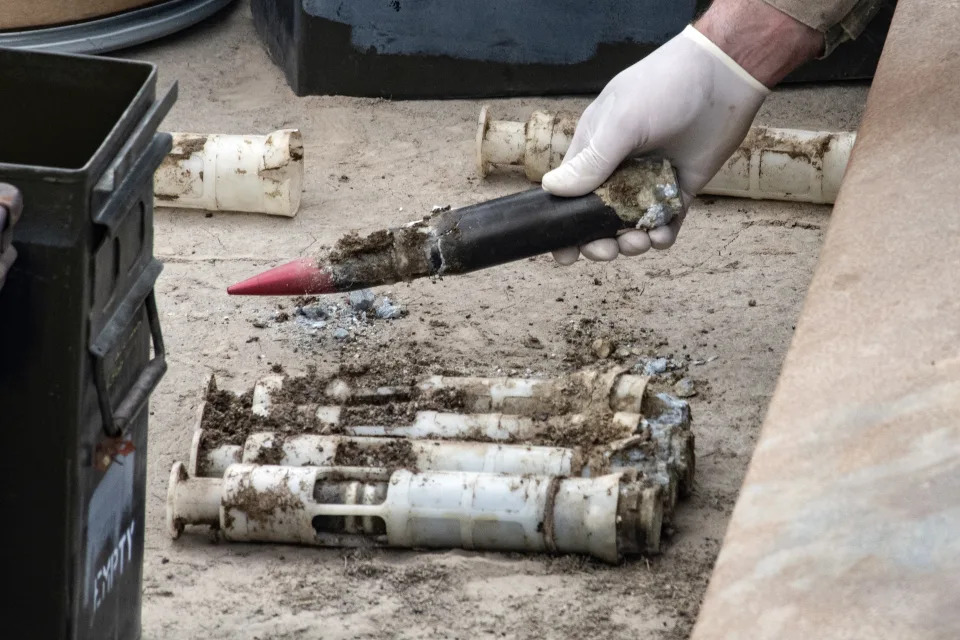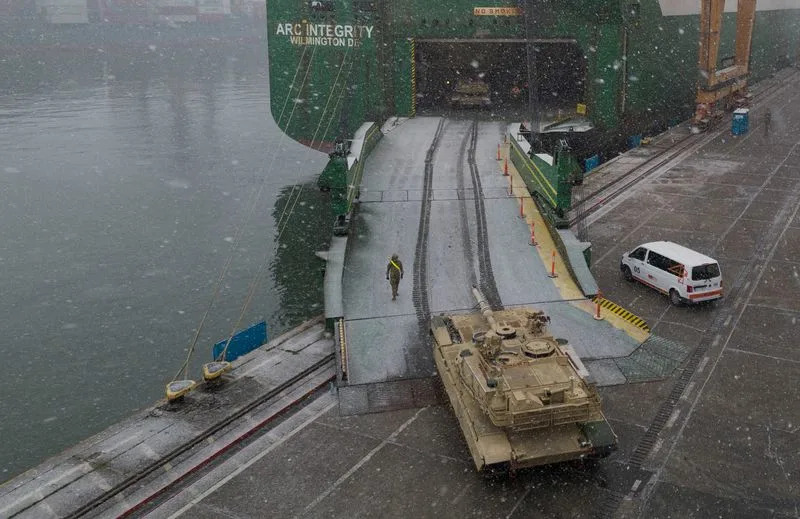A look at the uranium-based ammo the US is sending to Ukraine
TARA COPP
Updated Wed, September 6, 2023

Russia Ukraine War Uranium Explainer
WASHINGTON (AP) — The U.S. on Wednesday announced it was sending depleted uranium anti-tank rounds to Ukraine, following Britain's lead in sending the controversial munitions to help Kyiv push through Russian lines in its grueling counteroffensive.
The 120 mm rounds will be used to arm the 31 M1A1 Abrams tanks the U.S. plans to deliver to Ukraine in the fall.
Such armor-piercing rounds were developed by the U.S. during the Cold War to destroy Soviet tanks, including the same T-72 tanks that Ukraine now faces in its counteroffensive.
Depleted uranium is a byproduct of the uranium enrichment process needed to create nuclear weapons. The rounds retain some radioactive properties, but they can’t generate a nuclear reaction like a nuclear weapon would, RAND nuclear expert and policy researcher Edward Geist said.
When Britain announced in March it was sending Ukraine the depleted uranium rounds, Russia falsely claimed they have nuclear components and warned that their use would open the door to further escalation. In the past, Russian President Vladimir Putin has suggested the war could escalate to nuclear weapons use.
A look at depleted uranium ammunition:
WHAT IS DEPLETED URANIUM?
Depleted uranium is a byproduct of the process to create the rarer, enriched uranium used in nuclear fuel and weapons. Although far less powerful than enriched uranium and incapable of generating a nuclear reaction, depleted uranium is extremely dense — more dense than lead — a quality that makes it highly attractive as a projectile.
“It’s so dense and it’s got so much momentum that it just keeps going through the armor — and it heats it up so much that it catches on fire,” Geist said.
When fired, a depleted uranium munition becomes “essentially an exotic metal dart fired at an extraordinarily high speed,” RAND senior defense analyst Scott Boston said.
In the 1970s, the U.S. Army began making armor-piercing rounds with depleted uranium and has since added it to composite tank armor to strengthen it. It also has added depleted uranium to the munitions fired by the Air Force’s A-10 close air support attack plane, known as the tank killer. The U.S. military is still developing depleted uranium munitions, notably the M829A4 armor-piercing round for the M1A2 Abrams main battle tank, Boston said.
WHAT HAS RUSSIA SAID?
In March, Putin warned that Moscow would "respond accordingly, given that the collective West is starting to use weapons with a ‘nuclear component.’" And Foreign Minister Sergey Lavrov said the munitions were “a step toward accelerating escalation.”
Putin followed up several days later by saying Russia would respond to Britain's move by stationing tactical nuclear weapons in neighboring Belarus. Putin and the Belarusian president said in July that Russia had already shipped some of the weapons.
There was no immediate reaction from the Kremlin to the U.S. announcement, which came late Wednesday during a visit to Kyiv by Secretary of State Antony Blinken.
The Pentagon has defended the use of the munitions. The U.S. military “has procured, stored, and used depleted uranium rounds for several decades, since these are a longstanding element of some conventional munitions,” Pentagon spokesman Marine Corps Lt. Col. Garron Garn said in a statement in March in response to a query from The Associated Press.
The rounds have “saved the lives of many service members in combat,” Garn said, adding that “other countries have long possessed depleted uranium rounds as well, including Russia.”
Garn would not discuss whether the M1A1 tanks being readied for Ukraine would contain depleted uranium armor modifications, citing operational security.
NOT A BOMB, BUT STILL A RISK
While depleted uranium munitions are not considered nuclear weapons, their emission of low levels of radiation has led the U.N. nuclear watchdog to urge caution when handling and warn of the possible dangers of exposure.
The handling of such ammunition “should be kept to a minimum and protective apparel (gloves) should be worn,” the International Atomic Energy Agency cautions, adding that “a public information campaign may, therefore, be required to ensure that people avoid handling the projectiles.
"This should form part of any risk assessment and such precautions should depend on the scope and number of ammunitions used in an area.”
The IAEA notes that depleted uranium is mainly a toxic chemical, as opposed to a radiation hazard. Particles in aerosols can be inhaled or ingested, and while most would be excreted again, some can enter the blood stream and cause kidney damage.
“High concentrations in the kidney can cause damage and, in extreme cases, renal failure,” the IAEA says.
The low-level radioactivity of a depleted uranium round “is a bug, not a feature” of the munition, Geist said, and if the U.S. military could find another material with the same density but without the radioactivity it would likely use that instead.
Depleted uranium munitions, as well as depleted uranium-enhanced armor, were used by U.S. tanks in the 1991 Gulf War against Iraq’s T-72 tanks and again in the invasion of Iraq in 2003, as well as in Serbia and in Kosovo.
U.S. troops have questioned whether some of the ailments they now face were caused by inhaling or being exposed to fragments after a munition was fired or their tanks were struck, damaging uranium-enhanced armor.
In a social media post on Telegram, Russian Foreign Ministry spokeswoman Maria Zakharova slammed the U.S. decision to give Ukraine the munitions, writing, “What is this: a lie or stupidity?” She said an increase in cancer has been noted in places where ammunition with depleted uranium was used.
___
Associated Press writers Lolita C. Baldor and Aamer Madhani in Washington, Frank Jordans in Berlin and Menelaos Hadjicostis in Nicosia, Cyprus, contributed to this report.
___
Follow the AP's coverage of Russia's war in Ukraine at https://apnews.com/hub/russia-ukraine.
Russia says US supply of depleted uranium weapons to Ukraine is 'criminal'
Reuters
Thu, September 7, 2023

NATO's Operation Atlantic Resolve in Gdynia
(Reuters) - Russian Deputy Foreign Minister Sergei Ryabkov said on Thursday that the US supply of depleted uranium weapons to Ukraine was "a criminal act", state media reported.
The Pentagon on Wednesday announced a new security assistance package worth up to $175 million for Ukraine, including depleted uranium ammunition for U.S. Abrams tanks.
A by-product of uranium enrichment, depleted uranium is used for ammunition because its extreme density gives rounds the ability to easily penetrate armor plating. Critics say there are dangerous health risks from ingesting or inhaling depleted uranium dust, including cancers and birth defects.
"This is not just an escalatory step, but it is a reflection of Washington’s outrageous disregard for the environmental consequences of using this kind of ammunition in a combat zone. This is, in fact, a criminal act, I cannot give any other assessment," TASS quoted Ryabkov as saying.
In a speech at a security seminar, he also reiterated previous warnings by Russia about the risk of a nuclear war, because of what he called Western "pressure" on Moscow.
"Now this pressure is dangerously balancing on the brink of direct armed conflict between nuclear powers," he said.
Russia has long accused the West of using Ukraine to wage a proxy war aimed at inflicting a "strategic defeat" on Moscow. The United States and its allies say they are arming Ukraine to defend itself against Russia's invasion and recover territory seized by Moscow in the course of the 18-month war.
Russia's deployment of tactical nuclear weapons in Belarus was proceeding on schedule, Ryabkov said.
"Several stages have now been completed in terms of creating the appropriate infrastructure and re-equipping the corresponding carriers. This work continues."
Moscow announced the deployment earlier this year, calling it a deterrent to the West.
(Reporting by Reuters; Editing by Michael Perry)
No comments:
Post a Comment